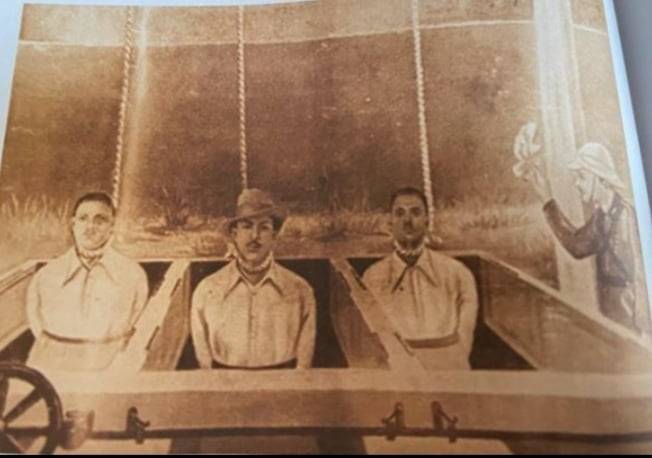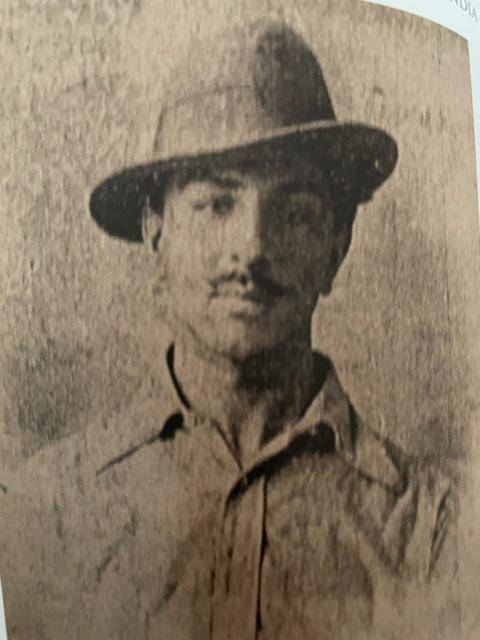Jis dhaj say koi maqtal mein gaya woh shan salamat rehti hai
Yeah jan tu aani jaani hai is jan kei koi baat nehein
They pride with which one meets one’s end is what lives for ever
This life only comes and goes so no need to fuss over it too much
(Faiz)
90 Years ago, on 23rd March three young men were hanged to their deaths inside Lahore Jail. The British authorities had gone to great pains to do this secretly. The date of execution publicly announced was 24th of March so many were expecting a last-minute reprieve or stay. After the execution for which allegedly no magistrate agreed to supervise and an honorary judge was drafted in the bodies were not handed over to the relatives but removed after making a hole in the back wall of the jail, cremated under cover of darkness at an unknown location and the ashes thrown in river Sutlej
These men were Bhagat Singh aged 23, Sukhdev Thapar aged 23 and Shivaram Rajguru aged 22.
They had been convicted by a special tribunal in the so-called Lahore conspiracy case that had resulted in the death of an English police officer.

The trial and execution produced widespread public interest and in case of Bhagat Singh it brought him everlasting fame which endures even to this day. Countless articles and scores of books have been written on him. He has been the hero of many songs, poems and plays. Bollywood has been enthralled by him and many films have been made on him the most famous being Manoj Kumar’s Shaheed in 1965. Leaving aside his movie star fame Bhagat Singh is widely admired at grassroot level by the public all over Punjab and beyond.
Of course, this popularity is lot more East of the border where towns and villages have been named after him. West of the border in Pakistan, whose son of soil he was being born in Lyallpur district, died in Lahore and cremated outside Guru Singh Wala village, all areas now in Pakistan, only people who admire Bhagat Singh are a handful of common Punjabis who have been demanding that the area where Bhagat Singh was executed and is now a major crossing is named Bhagat Singh Square, a demand that Lahore Municipal Authority once accepted before backing out due to a backlash by the different groups.
And while at official level Bhagat Singh does not exist for Pakistan there is an amusing side to this.
When I was in school I waited for 23rd of March every year with great anticipation and excitement. This is the date on which Pakistan celebrates its National Day to commemorate the passing of the Pakistan Resolution in Lahore by Muslim League in 1940. My reason for looking forwards to this day was hardly patriotic. The thing was that on this day a huge military parade was held in Rawalpindi Racecourse Ground.
And as in those days I was very keen on military equipment for me this was the opportunity to watch all types of tanks, armoured vehicles, guns etc rumbling past as one sat in the audience. And by far the most anticipated event was the fly past by Pakistan Airforce led by the in-office Chief in the best fighter aircraft the force had in its inventory.
And so ironically, while at official level, Bhagat Singh does not exist for Pakistan, in my opinion without knowing or wanting it Pakistan continues to pay tribute to him by holding a military parade in his honour, something not even India does!
Some find this popularity of Bhagat Sing surprising. However, for sure it was not just a fluke and in fact it was something purposely engineered by Singh and his party.
The British had in place a very effective system of censorship and therefore Bhagat Singh and his fellow activists were unable to spread their message on a mass scale. To counteract this Bhagat Singh who was an educated, intelligent, glamorous and articulate man as well as good looking planned the whole campaign which led to his arrest and trial. Even the famous photograph of him with the stylishly tilted hat was purposely created in Ramnath studio in Delhi a few days before he courted arrest and then distributed widely after the arrest.
He knew what it will lead to and was never in doubt that this will be his death but this was no suicide for the trial gave immense popularity to Singh. It was through this public attention that he was hoping to spread his message on a mass scale.
Unfortunately, it did not achieve the real purpose Bhagat Singh wanted to and sadly he was unable to get his message across in its entirety.
During the trial the British tried to portray Singh and his comrades as lunatics, the general public however concluded that they were anti-colonial freedom fighters and their death gave them the status of martyrs in the war against the British imperialism. While it is a fact that they were genuine anti-colonial activists that is not all, there was more to Bhagat Singh and his struggle, something that has been lost.
Even Bhagat Singh’s family (his nephew now heads Bhagat Singh Research Group) have lamented that his real message has been distorted by Bollywood movies.
As a young student in Lahore Bhagat Singh joined the Hindustan Republican Association (HRA) which had been inspired by the anti-British Republican uprising in Ireland. After this organization suffered significantly due to the crackdown following the Kakori Conspiracy case Bhagat Singh became one of its leaders, under his direction the name of the organization was changed to Hindustan Socialist Republican Association (HSRA), a change that was not just in name but meant significant change in the aim and purpose of the organization.
The point to note it that the portrayal of Bhagat Singh and his comrades as only anti-British, anti-colonial freedom fighters is not correct. What they actually wanted and for what they gave their lives is best understood by quoting Bhagat Singh’s words,
“We want a socialist revolution, the indispensable preliminary to which is the political revolution. That is what we want. The political revolution does not mean the transfer of state (or more crudely, the power) from the hands of the British to the Indian.”
Elaborating on the above point Sigh stated that for workers there is no difference if Lord Reading is the head of the Indian government or Sir Purshotamdas Thakordas and for peasants no difference if Sir Tej Bahadur Sapru replaces Lord Irwin.
He clearly states that what they seek is a real top to bottom rearrangement of the Indian society on socialist lines.
The slogan which Bhagat Singh and his comrades shouted again and again in court during the trial was ‘Inqilab Zindabad (Long live revolution) not “Azadi, Azadi (Freedom, Freedom)”
And so, I am sure Bhagat Singh and his associates would have derived little if any pleasure when the British left in 1947. In fact, quite certainly they would have agreed with those who thought like them, like Sadat Hasan Manto who while the firecrackers are going on outside in Bombay streets at midnight on 15th August 1947 was writing,
"Hindustan azaad ho gaya tha. Pakistan aalum-e-wajud mein aate hi azaad ho gaya tha, lekin insaan donon mumlikaton mein ghulam raha, Ta'asub ka ghulam ... mazhabi junoon ka ghulam ... haiwaniyat-o-barbariyat ka ghulam.
Hindustan has become free, Pakistan became free even before it was born. Yet humans in both countries remains enslaved…. slaves of bigotry…..Slaves of religious fanaticism……slaves of inhumanity and barbarity”
And like Faiz Ahmed Faiz who around the same time 900 miles away in Lahore was writing,
"Yeh daaġh daaġh ujālā ye shab-gazīda sahar
vo intizār thā jis kā ye vo sahar to nahīñ
najāt-e-dīda-o-dil kī gharī nahīñ aa.ī
chale-chalo ki vo manzil abhī nahīñ aa.ī
This blood splattered morning, this dark like night dawn
This is not the dawn we were waiting for
The moment of liberation for sight and heart has not yet arrived
March on for our destination has not yet arrived"






